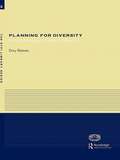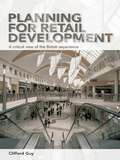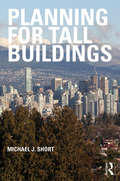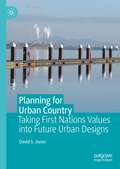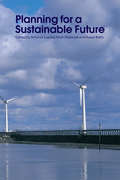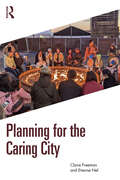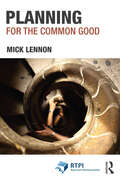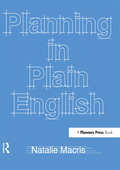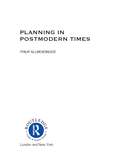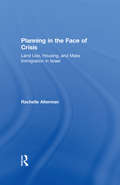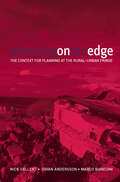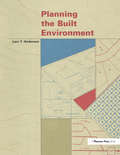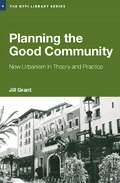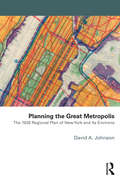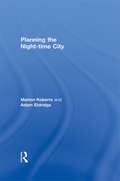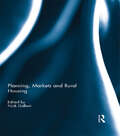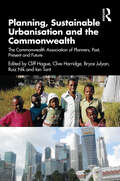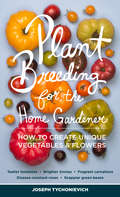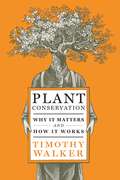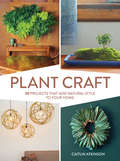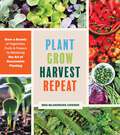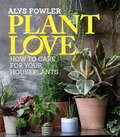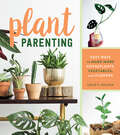- Table View
- List View
Planning for Crime Prevention: A Transatlantic Perspective (RTPI Library Series #Vol. 3)
by Ted Kitchen Richard H SchneiderCrime and the fear of crime are issues high in public concern and on political agendas in most developed countries. This book takes these issues and relates them to the contribution that urban planners and participative planning processes can make in response to these problems. Its focus is thus on the extent to which crime opportunities can be prevented or reduced through the design, planning and management of the built environment. The perspective of the book is transatlantic and comparative, not only because ideas and inspiration in this and many other fields increasingly move between countries but also because there is a great deal of relevant theoretical material and practice in both the USA and the UK which has not previously been pulled together in this systemic manner.
Planning for Diversity: Policy and Planning in a World of Difference (RTPI Library Series #Vol. 8)
by Dory ReevesThe practical importance of diversity and equality for spatial planning and sustainable development is still not widely understood. Using international examples, this book shows planners and educationalists the benefits of building in a consideration of diversity and equality at each stage and level of planning.Despite being one of the most diverse and gender balanced of the built environment professions, complacency has been widespread in planning. This book shows why a diverse profession is important and drawing on a wide range of good practice, shows how those involved in planning can develop their sensitivity to and expertise in diversity and equality.
Planning for Retail Development: A Critical View of the British Experience
by Clifford GuyWritten by a leading expert in the field, this is the first thorough critical review of retail planning policy in Britain (including Scotland and Wales). It covers recent changes in government policy and guidance, and examines retail policy within a broader economic and social context. Planning for Retail Development explains key events and debates in the evolution of retail planning policy, at central and local government levels, since the 1960s and draws contrasts between the 1980s, a period in which retail developers were encouraged by central government to expand away from town centres, and the more recent emphasis on protection and promotion of town centres as the most appropriate location for new development. The book develops a critical evaluation of past and present retail planning policies, based upon analyses of retailers’ objectives and of typical consumer shopping behaviour. Relationships between retail planning and wider societal concerns, including sustainable development, social inclusion and urban regeneration are also examined and analysed and guidelines for future policy objectives and content are drawn.
Planning for Tall Buildings
by Michael J. ShortIn a time of recession, the challenge of building and planning for tall buildings has become even more complex; the economics of development, legislative and planning frameworks, and the local politics of development must be navigated by those wishing to design and construct new tall buildings which fit within the fabric of their host cities. This book is a timely contribution to the debate about new tall buildings and their role and effect on our cities. It is divided into two main parts. In part one, the relationship between tall buildings and planning is outlined, followed by an exploration of the impacts that construction of tall buildings can have. It focuses, in particular, on the conservation debates that proposals for new tall buildings raise. The first part ends with an analysis of the way in which planning strategies have evolved to deal with the unique consequences of tall buildings on their urban locations. The second part of the book focuses on seven examples of medium-sized cities dealing with planning and conservation issues, and implications that arise from tall buildings. These have been chosen to reflect a wide range of methods to either encourage or to control tall buildings that cities are deploying. The case studies come from across the western world, covering England (Manchester, Liverpool, Newcastle and Birmingham), Norway (Oslo), Ireland (Dublin) and Canada (Vancouver) and represent a broad spectrum of approaches to dealing with this issue.In drawing together the experiences of these varied cities, the book contributes to the ongoing debate about the role of the tall building in our cities, their potential impacts, and experiences of those who use and inhabit them. The conclusions outline how cities should approach the strategic planning of tall buildings, as well as how they should deal with the consequences of individual buildings, particularly on the built heritage.
Planning for Urban Country: Taking First Nations Values into Future Urban Designs
by David S. JonesPlanning for Urban Country addresses a major gap in knowledge about the translation of Aboriginal values and Country Plans into Australia’s built environment contexts. How do you ‘heal’ Country if it has been devastated by concrete and bitumen, excavations and bulldozing, weeds and introduced plants and animals, and surface, aerial and underground contaminants? How then do Aboriginal values and Country Plan aspirations address urban environments? In this book, David Jones explores the major First Nations-informed design and planning transformations in Djilang / Greater Geelong since 2020. Included are short-interlinked essays about the political and cultural context, profiles of key exemplar architectural, landscape and corridor projects, a deep explanation of the legislative, policy and statutory precedents, opportunities and environment that has enabled these opportunities, and the how Wadawurrung past-present-future values have been scaffolded into these changes.
Planning for a Sustainable Future
by Simin Davoudi Antonia Layard Susan BattySustainable Development is now firmly on the planning agenda and is an issue neither practitioner nor academic can afford to ignore. Planning for a Sustainable Future provides a multi-disciplinary overview of sustainability issues in the land use context, focusing on principles and their application, the legal, political and policy context and the implication of sustainable development thinking for housing, urban design and property development as well as waste and transport. The book concludes by considering how sustainable and unsustainable impacts alike can be measured and modelled, providing real tools to move beyond rhetoric into practice.
Planning for the Caring City
by Claire Freeman Etienne NelAs the world has become increasingly urbanised and planetary well-being ever more threatened, questions have emerged over just what the priorities should be for how we live in cities. Clearly for many the current ways of planning and managing city environments are not working, given so many of their human and non-human inhabitants struggle on a daily basis to maintain their well-being and survival. Different approaches to city development are crucial if they are to be inclusive places where all can thrive. Ensuring that cities are safe and sustainable and provide a level of care for all their residents places a significant mandate on those who manage cities and on planners in particular. This book examines all the parts of the city where care needs to be incorporated, how we plan, create nurturing environments, include all who live there, build sensitively, support meaningful livelihoods, and enable compassionate governance. With planners in mind this book examines why care is needed in the urban environment, and drawing on real world examples examines how it can be applied in an effective and empowering fashion.
Planning for the Common Good (RTPI Library Series)
by Mick LennonAppeals to the ‘common good’ or ‘public interest’ have long been used to justify planning as an activity. While often criticised, such appeals endure in spirit if not in name as practitioners and theorists seek ways to ensure that planning operates as an ethically attuned pursuit. Yet, this leaves us with the unavoidable question as to how an ethically sensitive common good should be understood. In response, this book proposes that the common good should not be conceived as something pre-existing and ‘out there’ to be identified and applied or something simply produced through the correct configuration of democracy. Instead, it is contended that the common good must be perceived as something ‘in here,’ which is known by engagement with the complexities of a context through employing the interpretive tools supplied to one by the moral dimensions of the life in which one is inevitably embedded. This book brings into conversation a series of thinkers not normally mobilised in planning theory, including Paul Ricoeur, Alasdair MacIntyre and Charles Taylor. These shine light on how the values carried by the planner are shaped through both their relationships with others and their relationship with the ‘tradition of planning’ – a tradition it is argued that extends as a form of reflective deliberation across time and space. It is contended that the mutually constitutive relationship that gives planning its raison d’être and the common good its meaning are conceived through a narrative understanding extending through time that contours the moral subject of planning as it simultaneously profiles the ethical orientation of the discipline. This book provides a new perspective on how we can come to better understand what planning entails and how this dialectically relates to the concept of the common good. In both its aim and approach, this book provides an original contribution to planning theory that reconceives why it is we do what we do, and how we envisage what should be done differently. It will be of interest to scholars, students and practitioners in planning, urban studies, sociology and geography.
Planning in Plain English: Writing Tips for Urban and Environmental Planners
by Natalie MacrisIn this volume, the author draws from more than a decade of editing experience to explain how to craft clear, understandable, and highly readable planning documents. The author suggests ways to overcome planners' most common writing foibles: acronymns, jargon, and overuse of the passive voice. And the author provides handy lists to transform mushy nouns into powerful verbs, pare down bloated sentences, and translate ""bureaucratese"" into everyday language. The author even includes practice exercises designed to help you recognize and overcome bad writing habits. But even the best writing skills won't help if your document is organized poorly and aimed at the wrong audience.The author also explains why it's essential to know who your readers are before you start writing and how to organize your work so that it will be easy to understand and use."
Planning in Postmodern Times (RTPI Library Series)
by Philip AllmendingerPostmodern social theory has provided significant insights into our understanding of society and its components. Key thinkers including Foucault, Baudrillard and Lyotard have challenged existing ideas about power and rationality in society. This book analyses planning from a postmodern perspective and explores alternative conceptions based on a combination of postmodern thinking and other fields of social theory. In doing so, it exposes some of the limits of postmodern social theory while providing an alternative conception of planning in the twenty-first century.This title will appeal to anyone interested in how we think and act in relation to cities, urban planning and governance.
Planning in the Face of Crisis: Land Use, Housing, and Mass Immigration in Israel (Cities And Regions Ser.)
by Rachelle AltermanCritics of urban and regional planning argue that it is best suited to manage incremental change. Can a planner's skills and expertise be effective in handling a major crisis and large-scale change? The mass immigration from the former Soviet Union to Israel in the 1990s offers the opportunity to study one of the largest-scale (non-disaster) crisis situations in a democratic, advanced-economy country. This book recounts the fascinating saga of how policymakers and planners at both the national and local levels responded to the formidable demand for housing and massive urban growth. Planners forged new housing and land-use policies, and applied a streamlined (but controversial) planning law. The outputs were impressive. The outcomes and impacts changed the landscape and human-scape of Israel, heightening dilemmas of land use and urban policy in this high-density country.
Planning on the Edge
by Johan Andersson Nick Gallent Marco BianconiMore than a tenth of the land mass of the UK comprises 'urban fringe': the countryside around towns that has been called 'planning's last frontier'. One of the key challenges facing spatial planners is the land-use management of this area, regarded by many as fit only for locating sewage works, essential service functions and other un-neighbourly uses. However, to others it is a dynamic area where a range of urban and rural uses collide. Planning on the Edge fills an important gap in the literature, examining in detail the challenges that planning faces in this no-man’s land. It presents both problems and solutions, and builds a vision for the urban fringe that is concerned with maximising its potential and with bridging the physical and cultural rift between town and country. Its findings are presented in three sections: the urban fringe and the principles underpinning its management sectoral challenges faced at the urban fringe (including commerce, energy, recreation, farming, and housing) managing the urban fringe more effectively in the future. Students, professionals and researchers alike will benefit from the book's structured approach, while the global and transferable nature of the principles and ideas underpinning the study will appeal to an international audience.
Planning the Built Environment
by Larz AndersonPlanning the Built Environment takes a systematic, technical approach to describing how urban infrastructures work. Accompanied by detailed diagrams, illustrations, tables, and reference lists, the book begins with landforms and progresses to essential utilities that manage drainage, wastewater, power, and water supply. A section on streets, highways, and transit systems is highly detailed and practical. Once firmly grounded in these "macro" systems, Planning the Built Environment examines the physical environments of cities and suburbs, including a discussion of critical elements such as street and subdivision planning, density, and siting of community facilities. Each chapter includes essential definitions, illustrations and diagrams, and an annotated list of references. This timely book explains new physical planning methods and current thinking on cluster development, new urbanism, and innovative transit planning and development. Planners, architects, engineers, and anyone who designs or manages the physical components of urban areas will find this book both an authoritative reference and an exhaustive, understandable technical manual of facts and best practices. Instructors in planning and allied fields will appreciate the practical exercises that conclude each chapter: valuable learning tools for students and professionals alike.
Planning the Good Community: New Urbanism in Theory and Practice (RTPI Library Series)
by Jill GrantAn examination of new urban approaches both in theory and in practice. Taking a critical look at how new urbanism has lived up to its ideals, the author asks whether new urban approaches offer a viable path to creating good communities. With examples drawn principally from North America, Europe and Japan, Planning the Good Community explores new urban approaches in a wide range of settings. It compares the movement for urban renaissance in Europe with the New Urbanism of the United States and Canada, and asks whether the concerns that drive today’s planning theory – issues like power, democracy, spatial patterns and globalisation- receive adequate attention in new urban approaches. The issue of aesthetics is also raised, as the author questions whether communities must be more than just attractive in order to be good. With the benefit of twenty years’ hindsight and a world-wide perspective, this book offers the reader unparalleled insight as well as a rigorous and considered critical analysis.
Planning the Great Metropolis: The 1929 regional plan of New York and its environs (Planning, History and Environment Series)
by David A. JohnsonAs the Regional Plan Association embarks on a Fourth Regional Plan, there can be no better time for a paperback edition of David Johnson’s critically acclaimed assessment of the 1929 Regional Plan of New York and Its Environs. As he says in his preface to this edition, the questions faced by the regional planners of today are little changed from those their predecessors faced in the 1920s. Derided by some, accused by others of being the root cause of New York City’s relative economic and physical decline, the 1929 Plan was in reality an important source of ideas for many projects built during the New Deal era of the 1930s. In his detailed examination of the Plan, Johnson traces its origins to Progressive era and Daniel Burnham’s 1909 Plan of Chicago. He describes the making of the Plan under the direction of Scotsman Thomas Adams, its reception in the New York Region, and its partial realization. The story he tells has important lessons for planners, decision-makers and citizens facing an increasingly urban future where the physical plan approach may again have a critical role to play.
Planning the Night-time City
by Marion Roberts Adam EldridgeThe night-time economy represents a particular challenge for planners and town centre managers. In the context of liberalised licensing and a growing culture around the '24-hour city', the desire to foster economic growth and to achieve urban regeneration has been set on a collision course with the need to maintain social order. Roberts and Eldridge draw on extensive case study research, undertaken in the UK and internationally, to explain how changing approaches to evening and night-time activities have been conceptualised in planning practice. The first to synthesise recent debates on law, health, planning and policy, this research considers how these dialogues impact upon the design, management, development and the experience of the night-time city. This is incisive and highly topical reading for postgraduates, academics and reflective practitioners in Planning, Urban Design and Urban Regeneration.
Planning, Markets and Rural Housing
by Nick GallentThis book analyses the key forces affecting the affordability of rural homes in Britain and the changing shape of housing markets. It takes as its starting point, demographic trends impacting upon rural communities and upon market dynamics. From this point, it explores consequent patterns of housing affordability, examining changing opportunities in the rental and sale markets, at different spatial scales. The book also focuses on how markets are analysed, and how data are selectively used to demonstrate low levels of affordability, or a lack of need for additional housing in small village locations.Building on the demographic theme, the book considers the housing implications of an aging population, before the focus finally shifts to community initiative in the face of housing undersupply and planning's future role in delivering and procuring a more constant and predictable supply of affordable homes. In a speculative conclusion, the book ends by examining the current political trajectory in England, and the prospects for housing in the countryside in the context of localism and neighbourhood planning at a village level.This book was published as a special issue of Planning Practice and Research.
Planning, Sustainable Urbanisation and the Commonwealth: The Commonwealth Association of Planners, Past, Present and Future
by Cliff Hague Clive Harridge Bryce Julyan Ruiz Nik Ian TantBy 2050, an additional 2.5 billion people will be living in the world’s towns and cities, almost 50% of them in the 56 Commonwealth countries. To a significant extent, the future of the planet hangs on how cities and human settlements are managed. It is in our cities that the emissions creating climate catastrophe are stoked and where change can – and must – make a difference at scale. Food security, water, basic services, migration, shelter, jobs, environment: sustainable urbanisation is about changing direction to strive for a fairer and less environmentally damaging future. This well-illustrated book by authors from around the Commonwealth tells how the Commonwealth Association of Planners across five decades has campaigned to make a difference. It also looks ahead, scoping the urgent, practical action that is now required.
Plant Breeding for the Home Gardener: How to Create Unique Vegetables and Flowers
by Joseph TychonievichBrighter zinnias, fragrant carnations, snappier green beansPlant Breeding for the Home Gardener makes it easier than ever to breed and grow your own varieties of vegetables and flowers. This comprehensive and accessible guide explains how to decide what to breed, provides simple explanations on how to cross plants, and features a basic primer on genetics and advanced techniques. Case studies provide breeding examples for favorite plants like daffodils, hollyhocks, roses, sweet corn, and tomatoes.
Plant Conservation: Why It Matters and How It Works
by Timothy WalkerPlants’ ability to turn sunlight into energy makes them the basis for all life; without them there is no life. And they are more than just a food source—they provide us with fuel, fibers, and pharmaceuticals. Global warming and the destruction of natural habitats are a serious threat to many plants, and there are worldwide efforts to mitigate the disaster. Plant Conservation tackles this essential topic head on. Timothy Walker, as the director of the Oxford Botanical Garden, a leader in the field of plant conservation, plays a key role in this effort. He highlights what is happening now, from cataloging the world’s flora to conservation efforts like protecting plants from overcollecting. He also shows home gardeners how they can become involved, whether by growing their own food to decrease reliance on large agriculture or by making smart plant choices by growing natives and avoiding invasives. Plant Conservation treats a critical topic in an accessible and optimistic way. It is required reading for students, professionals, and anyone with a keen interest in the importance of plants.
Plant Craft: 30 Projects that Add Natural Style to Your Home
by Caitlin AtkinsonDiscover the simple beauty of adding natural style to a space! Not everyone has a garden—but with only a handful of materials and a little bit of time, everyone can bring the beauty of nature into their home. Plant Craft features projects inspired by the natural world and made out of live plants, cut flowers, foraged branches, and more. You’ll learn how to create a colorful floral mural, an elegant table centerpiece, a serene underwater sculpture, a whimsical mobile, and more. The step-by-step instructions are clear, easy to follow, and fully illustrated with color photographs, and the projects vary in difficulty. Given the right care, they all have the potential to grace a home for a long time.
Plant Grow Harvest Repeat: Grow a Bounty of Vegetables, Fruits, and Flowers by Mastering the Art of Succession Planting
by Meg McAndrews Cowden&“Wonderfully written, beautifully illustrated, and everything you need to know to get more productivity out of your food garden.&” —Joe Lamp&’l, creator and executive producer, Growing a Greener World Discover how to get more out of your growing space with succession planting—carefully planned, continuous seed sowing—and provide a steady stream of fresh food from early spring through late fall. Drawing inspiration from succession in natural landscapes, Meg McAndrews Cowden teaches you how to implement lessons from these dynamic systems in your home garden. You&’ll learn how to layer succession across your perennial and annual crops; maximize the early growing season; determine the sequence to plant and replant in summer; and incorporate annual and perennial flowers to benefit wildlife and ensure efficient pollination. You&’ll also find detailed, seasonal sowing charts to inform your garden planning, so you can grow more anywhere, regardless of your climate. Plant Grow Harvest Repeat will inspire you to create an even more productive, beautiful, and enjoyable garden across the seasons—every vegetable gardener&’s dream.
Plant Love
by Alys FowlerHouseplants are more than just decorations. They turn a room into a living space and breathe life into our interiors. Not all of us can have a garden or even a window box, but everyone can own a houseplant - and everyone should. Not only are they an affordable and attractive way to add a decorative and personal touch to a space, indoor plants also have unique air purifying properties and their presence is good for our health and wellbeing. In this practical yet inspiring guide, gardening expert Alys Fowler explores all the possible indoor plant options available, helping you to find the perfect plant for any location, from cool, shady bedrooms to warm, sunny kitchen windowsills. As well as more traditional indoor plants, Alys looks at specialist plant groups such as indoor tropical edibles, orchids, cacti, succulents and climbers. With her encyclopedic knowledge and trademark inspirational style, this definitive guide will give you all the knowledge you need to care for your plants.
Plant Love
by Alys FowlerHouseplants are more than just decorations. They turn a room into a living space and breathe life into our interiors. Not all of us can have a garden or even a window box, but everyone can own a houseplant - and everyone should. Not only are they an affordable and attractive way to add a decorative and personal touch to a space, indoor plants also have unique air purifying properties and their presence is good for our health and wellbeing. In this practical yet inspiring guide, gardening expert Alys Fowler explores all the possible indoor plant options available, helping you to find the perfect plant for any location, from cool, shady bedrooms to warm, sunny kitchen windowsills. As well as more traditional indoor plants, Alys looks at specialist plant groups such as indoor tropical edibles, orchids, cacti, succulents and climbers. With her encyclopedic knowledge and trademark inspirational style, this definitive guide will give you all the knowledge you need to care for your plants.
Plant Parenting: Easy Ways to Make More Houseplants, Vegetables, and Flowers
by Leslie F. Halleck“Everything a plant parent needs to take their plant collection—and plant knowledge—to the next level.” —Maria Failla, founder, Bloom & Grow Radio podcast Do you have a passion for houseplants? A desire to grow more tomatoes? Do you want a garden bursting with colorful flowers? No matter what kind of plant fan you are, it’s easy to make more of your favorite plants—and it can be done for free! Plant Parenting is a beginner-friendly introduction to plant propagation. Leslie F. Halleck details the basic tools necessary, demystifies seed starting and saving, and shares easy-to-follow instructions for the most practical techniques for cutting, layering, dividing, and more. She also provides additional information on controlling pests and diseases and transplanting seedlings and cuttings. Charming, richly illustrated, and accessible, Plant Parenting is for anyone looking to make more of their favorite plants.

